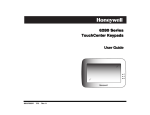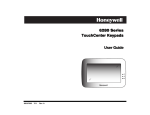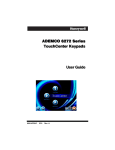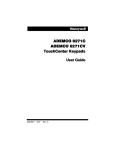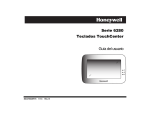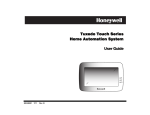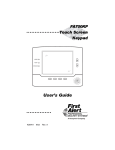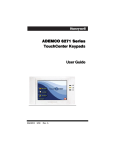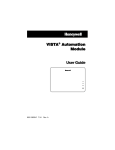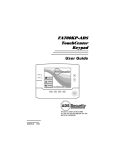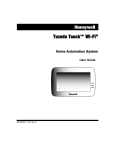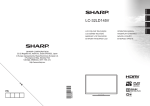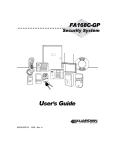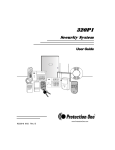Download 6280 Series TouchCenter Keypads User Guide
Transcript
6280 Series TouchCenter Keypads User Guide 800-07602V3 4/13 Rev. B Table of Contents ABOUT THE TOUCHCENTER .................................................................................................................................................................. 5 Introduction .......................................................................................................................................................................................... 5 The TouchCenter Interface .................................................................................................................................................................. 5 Navigating through the TouchCenter............................................................................................................................................ 6 About Your Home Screen............................................................................................................................................................. 6 Multi-Media Application ................................................................................................................................................................ 6 System Troubles .......................................................................................................................................................................... 8 User Codes .................................................................................................................................................................................. 9 Extended Functionality ................................................................................................................................................................. 9 LED Operation.............................................................................................................................................................................. 9 Safe Mode .................................................................................................................................................................................... 9 SECURITY ............................................................................................................................................................................................... 10 Introduction to Security System Operation ........................................................................................................................................ 10 How to Arm the System .............................................................................................................................................................. 11 How to Arm Multiple Partitions ................................................................................................................................................... 11 How to Display Faults ................................................................................................................................................................. 12 How to Bypass Zones ................................................................................................................................................................ 12 How to Clear Bypassed Zones ................................................................................................................................................... 13 How to Disarm the System ......................................................................................................................................................... 13 To disarm Multi-Partitions do the following: ................................................................................................................................ 14 How to Check the Status of Other Partitions .............................................................................................................................. 14 Fire and Carbon Monoxide Alarm Operation .............................................................................................................................. 15 In Case of Fire Alarm ................................................................................................................................................................. 15 Silencing and Clearing a Fire/Carbon Monoxide Alarm .............................................................................................................. 15 More Choices .................................................................................................................................................................................... 16 2 Table of Contents How to Clear/Hide a Control Panel Message ............................................................................................................................. 16 Advanced System Features ....................................................................................................................................................... 16 Console Emulation Mode ........................................................................................................................................................... 17 How to View the Event Log ........................................................................................................................................................ 17 How to Send Emergency Messages .......................................................................................................................................... 18 SETUP...................................................................................................................................................................................................... 19 Brightness and Volume Control .................................................................................................................................................. 19 Display & Audio Setup ................................................................................................................................................................ 19 Operating Modes ........................................................................................................................................................................ 19 Language Selection .................................................................................................................................................................... 20 Adjust the Screen Timeouts ....................................................................................................................................................... 20 Clean Screen.............................................................................................................................................................................. 21 Routine Care .............................................................................................................................................................................. 21 System Information .................................................................................................................................................................... 21 MULTI-MEDIA .......................................................................................................................................................................................... 22 Picture Setup .............................................................................................................................................................................. 22 Voice Messages ......................................................................................................................................................................... 23 USER SETUP ........................................................................................................................................................................................... 24 User Setup......................................................................................................................................................................................... 24 Authority Levels .......................................................................................................................................................................... 24 Access User Setup ..................................................................................................................................................................... 24 How to Add a User ..................................................................................................................................................................... 25 How to Delete a User ................................................................................................................................................................. 25 How to Edit a User ..................................................................................................................................................................... 25 Safe Mode .................................................................................................................................................................................. 26 Time/Date Setup................................................................................................................................................................................ 27 3 Table of Contents Setting Daylight Saving Time ..................................................................................................................................................... 27 Setting Current Time and Date ................................................................................................................................................... 27 Advanced Setup ......................................................................................................................................................................... 28 Keypad Test ............................................................................................................................................................................... 28 Keypad Reset ............................................................................................................................................................................. 29 GLOSSARY ............................................................................................................................................................................................. 30 4 About the TouchCenter Introduction Congratulations on your ownership of a Honeywell 6280 Series TouchCenter keypads which combines security and home automation. You've made a wise decision in choosing it, for it represents the latest in security protection technology today. This security system offers you burglary protection and provides fire, carbon monoxide and emergency protection. To realize the full potential of the system, it is important that you feel comfortable operating it. Your system may consist of one or more of the following: • • • • • 6280S (black/silver housing) 6280W (white housing) One or more other keypads for security system control Various sensors for perimeter and interior burglary protection, plus a selected number of strategically placed smoke, carbon monoxide or combustion detectors Lighting/output devices. The system uses microcomputer technology to monitor all zones, and provides appropriate information for display on the TouchCenter and/or other keypads used with the system. Your system may also have been programmed to automatically transmit alarm or status messages over the phone lines to a central alarm monitoring station. The TouchCenter Interface The 6280 Series graphical touch-screen keypads are Advanced User Interface (AUI) devices, which combine control of your security system, multi-media and premises lighting. With clear, simple controls on a touch-screen interface, the TouchCenter is both easy to learn and easy to use. As a security and home-automation interface, the TouchCenter may be accessed for: • Quick and easy security system operation • Multi-Media operation • Message storage and retrieval • Home output control 5 About the TouchCenter (cont'd) Navigating through the TouchCenter Navigation through the TouchCenter typically begins from the "Home" screen. This is the TouchCenter’s main default screen (starting screen) and is the first screen you see when the TouchCenter is powered up and initialized. It is from this screen that you select from the main menu. Once you have made your selection, you can navigate through various sub-menus by touching graphical icons or icons to perform the function you desire. About Your Home Screen Your "Home" screen is the gateway to your TouchCenter Keypad. From this screen you can: • control your security system, • control your multi-media applications, and • control the premises lighting. Your "Home" screen is displayed most of the time and is customizable via the Multi-Media Application. Ready To Arm Friday 01/06/2012 Security Light 02:46PM MultiMedia home_screen-V0 Multi-Media Application The Picture feature allows you to display personal photos (in a slide show format) via the external SD/SDHC card. It is recommended that you use the SD/SDHC card supplied with the keypad. In everyday handling, memory cards can become susceptible to malfunction and/or failure due to electrostatic discharges and the information on the card may be lost. In some extreme cases, the keypad may need to be reset. NOTE: Honeywell is not responsible for any loss of personal information (files, messages, photos, etc.) The background and icons shown on the “Home” screen in this manual are for example only. Your system installer may have changed the actual background and icons shown on your “Home” screen. Memory Card Insertion Insert the memory card (SD/SDHC Card) as shown. Tips for proper memory card handling: • Avoid touching the contacts on the card • Quit the slide show application before removing the memory card. 6 INSERT CARD 6280-004-V0 About the TouchCenter (cont'd) Navigation Icon Descriptions To aid in the navigation through the TouchCenter, a set of user-friendly icons has been provided. The appearance and function of these icons are described below. ICON ICON TITLE FUNCTION "Light” Allows you to turn certain devices on and off (if installed and programmed by your installer.) ICON ICON TITLE “Setup” "Security” Accesses "Security" screen. “Multi-Media” “Home” Returns you to the "Home" screen. “Picture” “Panic” “Back” Displays Emergency functions (as programmed by the installer). Note: This icon is displayed and active on all screens except while in the Clean Screen mode and during an LCD Display test in Diagnostics. "Message” Reverts to the last screen viewed. FUNCTION Allows access to “Setup” menus. Accesses the “Message” and “Picture” features. Allows user to display personal photos in a slide show format. Record and retrieve Voice Messages. “Voice Status” Allows user to hear system status. “Control Panel Message” This icon alerts the user to a “Control Panel Message”. Minimizing the Home Screen Icons When viewing wallpaper displays, the Home screen icons can be minimized by touching the “Minimize Home” icon. Touch the “Maximize Home” icon to maximize Home screen icons. Refer to the section Picture Setup. Minimize Home Setup Picture Maximize Home 7 Security Light Multi-Media About the TouchCenter (cont'd) System Troubles The “Security” screen also displays an Icon(s) if a system trouble(s) occurs. If a trouble Icon is shown, contact your alarm company. The following Icons may be shown as applicable to your system: ICON FUNCTION AC Loss – The system is not receiving AC power. Bell Failure – The system bell or siren has a problem. Note: This Icon displays when interfacing with residential panels only. Expander Failure – The system has a failure in an expansion module. Low Battery – The system battery, that powers the system during an AC power loss, is low. LRR Supervision Failure – The Communication Device used to communicate with the central station has a supervision failure. Max Attempts Exceeded – The system has exceeded the maximum attempts to communicate with the Central Station. Pager Failure – The system cannot communicate with an assigned pager. Telco-1 Cut – The system is not able to communicate with the central monitoring station over the primary phone line. Telco-2 Cut – The system is not able to communicate with the central monitoring station over the secondary phone line. Wireless Failure – The system is not able to communicate with its wireless devices. Note: If multiple faults exist, touch the More Choices icon and then the Show Zones icon to view and scroll through the complete list of faults. 8 About the TouchCenter (cont'd) User Codes Each user must be assigned a name with a corresponding 4-digit user code in order to gain access to authorized features and functions. Users for the system are programmed in a central user setup location that provides the specific questions for authorization level, partition assignment, and RF zone assignment. Extended Functionality Extended functions are advanced functions that can be accessed through a standard alpha keypad or through the console emulation mode on your TouchCenter touch screen. Refer to your Control Panel User Guide for these features. LED Operation The TouchCenter has three LEDs as follows: SD/SDHC CARD Slot ARMED (RED) LED ON – System is armed. OFF – System is not armed. READY (GREEN) LED ON – System is disarmed and ready to arm. OFF – System is armed or disarmed but not ready. If disarmed, faults or troubles are present. MESSAGE (YELLOW) LED FLASHING – The system contains new message(s) for the User. OFF – No new messages. RESET BUTTON Press to reset keypad 6280-001-V0 NOTE: If the Screen Blackout feature (*EN50131 Display) is enabled (see below) the keypad returns to the “Home” screen and the “Armed” and “Ready” status LEDs turn OFF after 30 seconds. The keypad will remain in this state until a valid user code is entered. *The EN50131 Display compliance feature is a European Standard designed to prevent unauthorized users from knowing the status of the Security System. Safe Mode The TouchCenter contains a Safe Mode of operation. In the rare event that the TouchCenter cannot successfully communicate in its graphic mode with the control panel, the Safe Mode is a backup mode that ensures that you can communicate with your system. Refer to the Safe Mode section. 9 Security Introduction to Security System Operation You can arm your system in one of three arming modes: Away, Stay, and Night. The following table lists the three different arming modes and the results of each. FEATURES FOR EACH ARMING MODE Arming Mode FUNCTION Exit Delay Entry Delay Perimeter Armed Interior Armed AWAY Press to arm when no one is staying on the premises. When armed in AWAY, the system sounds an alarm if a protected door or window is opened, or if any movement is detected inside the premises. Yes Yes Yes Yes STAY Press to arm when you are staying home, but might expect someone to use the entrance door later. When armed in STAY, the system sounds an alarm if a protected door or window is opened, but you may otherwise move freely throughout the premises. Yes Yes Yes No NIGHT Press to arm when you are staying home and do not expect anyone to use the entrance door. Your installer may have configured NIGHT Mode differently; have the installer describe the actual settings of this mode. Yes Yes (set for Away or Stay Mode) No (set for Instant or Maximum Mode) Yes Yes (set for Away or Maximum Mode) No (set for Stay or Instant Mode) See note below for Night Mode arming. Note: Night Mode (on Residential Panels Only) arms all perimeter zones plus all zones listed in Zone List 5. IMPORTANT: On commercial systems, “Away Auto Stay” mode is shown as “Away” mode (with all zones monitored). However, some interior zones may not be armed. ) indicates the TouchCenter Voice feature. Press the Voice Status Icon to hear system status. Wait Note: The Voice Status Icon ( 3 seconds and press again to hear Zone Faults or Trouble conditions. Voice status will annunciate even if Voice mode and Chime mode are disabled. Note that the Voice feature must be enabled (by the installer) for this icon to function correctly during an alarm condition. Note: There is a communicator delay of 30 seconds. This delay will prevent a report to the central station if the control panel is disarmed within 30 seconds after an intrusion alarm is triggered. This delay can be removed, or it can be increased up to 45 seconds at the option of the user by consulting with the installer. Note that fire-type alarms are normally reported without delay. 10 Security (cont'd) How to Arm the System Arming the system in any mode is performed in the same way, as described below. Note: Close all perimeter windows and doors before arming. Arm the system as follows: ICON ACTION 1. From the “Home” screen, touch the SECURITY icon. 2. Touch the selected arming icon. -a text message appears stating which zones are arming and whether or not there is an entry delay -the screen changes to display the remaining exit delay time, and -the exit delay time continues to count down to one. NOTES Note: If Quick Arm is Not enabled in your system, you are prompted to enter your User Code. • When the system is armed for Stay, Night Stay and Instant mode, the keypad beeps 3 times. • When the system is armed for Away and Maximum mode, you will hear steady beeps then rapid beeping during the last 10 seconds of Exit Delay. When exit delay time expires, the screen automatically changes to indicate the system is "Armed". Note: For CP-01 installations, Maximum Mode cannot be used. How to Arm Multiple Partitions Note: Some systems may not have multiple partitions and the “Arm Multi-Partitions” icon may not be displayed. To arm multiple partitions, do the following: ICON ACTION 1. From the “Home” screen, touch the Security icon and then the Arm MultiPartition icon. 2. Select the appropriate arming mode. 3. Enter the user code authorized to access other partition(s). 4. Highlight the partition from the list on the screen, and touch OK. 5. Select ALL to arm all partitions listed. NOTES Notes: • A user may have access to some or all of the available partitions. • If the user code is accepted, the system displays the partitions that the user has access to. When exit delay time expires, the screen automatically changes to indicate the system is "Armed". Note: If any zones are bypassed, a “Display Faults” icon ( displayed on this screen. 11 ) is Security (cont'd) How to Display Faults The Display Faults function is used when you see a “Not Ready Fault” message and want to determine where the fault is and what type of fault it is. To display faults do the following: ICON ACTION 1. From the "Security" screen, touch the Display Faults icon. 2. If the fault cannot be corrected, you may choose to bypass a zone by touching the zone to highlight it and then touching the Bypass Selected icon. Show Zones Icons Clear Bypasses Refresh Data Bypass Selected Bypass All NOTES A listing of faulted and/or bypassed zones is displayed. As applicable, take corrective action such as closing a window or door to correct the fault. Distressed Zone Icons Distressed Zones Alarm Troubles Faults Bypass Zones Low Battery ALL How to Bypass Zones The Bypass function is used when you want to arm your system with one or more zones left open. Bypassed zones are unprotected and do not cause an alarm when violated while your system is armed. • Residential systems do not allow you to bypass fire, carbon monoxide or emergency zones. On commercial fire systems, a specified user may be allowed to bypass fire, carbon monoxide and system zones if the user was enabled by your system installer. • Limits apply as to how many zones can be bypassed at one time. These limits are ten zones on residential systems and five zones on commercial systems. To bypass zones do the following: ICON ACTION 1. Touch the SECURITY icon. 2. Touch the MORE CHOICES icon. NOTES Note: If any zones are bypassed or faulted, a Display Faults icon is also displayed on this screen. 12 Security (cont'd) ICON ACTION 3. Touch the SHOW ZONES icon. NOTES While the TouchCenter is requesting and receiving the zone data from the control panel, the screen displays "Please Wait!". Then the zones, along with their current status, are displayed. 4. Highlight the zone(s) to be bypassed and touch the BYPASS SELECTED icon. 5. Enter your 4-digit user code. Note: If zones have already been bypassed, the top of this screen indicates “Ready Bypass”. The screen is displayed with the instructions "To Bypass Zones, Enter Code". 6. Touch the BACK icon to return to the “Arming” screen. The "More Choices" screen is displayed showing the system status as ReadyBypass. How to Clear Bypassed Zones A bypassed zone is automatically unbypassed when you disarm the system. If a zone is bypassed, you can remove the bypass as follows: ICON ACTION 1. Touch the SHOW ZONES icon. 2. Touch the CLEAR BYPASSES icon. 3. Enter your 4-digit user code. The "More Choices" screen is displayed showing the system as “Ready to Arm”. NOTES While the TouchCenter is requesting and receiving the zone data from the control panel, the screen displays "Please Wait!". Then the zones, along with their current status, are displayed. Note: If the system is armed and you unbypass a zone, it disarms the system. If zones are still faulted (not ready) the system will indicate the status as “Not Ready Fault”. How to Disarm the System IMPORTANT: If you return to your home or business and the main burglary sounder is on, DO NOT enter the premises, but call the police from a nearby safe location. If you return to your home or business after an alarm has occurred and the main sounder has shut itself off, the TouchCenter beeps rapidly upon entering, indicating that an alarm has occurred during your absence. LEAVE IMMEDIATELY and CONTACT THE POLICE from a nearby safe location. The system may be disarmed using either of two methods. One method is employed when you enter the premises and the other is when you have been in the premises with the system armed (i.e., Stay and Night arming modes). 13 Security (cont'd) To disarm the system when entering the premises: The TouchCenter automatically displays the Entry Delay Active screen when you enter the premises: ICON ACTION 1. Enter your 4-digit user code. The partition is disarmed and the "Arming" screen is displayed showing the system as Ready to Arm. NOTES Note: If you have a commercial system and a time window has been defined for when you may disarm the system, the system does not disarm if you are outside that time window. To disarm the system when already in the premises: ICON ACTION 1. Press the Disarm icon. 2. Enter your 4-digit user code. NOTES To disarm Multi-Partitions do the following: ICON ACTION 1. From the “Home” screen, press the Security icon. 2. Press the Arm Multi-Partition icon. 3. Press the Disarm icon. 4. Enter your 4-digit user code. 5. Highlight the partition(s) to disarm and press OK, or press ALL to disarm all partitions. NOTES The keypad displays “Multi-Partition Arming”. How to Check the Status of Other Partitions This system supports between one and eight Partitions (depending on the system). Partitioning enables a single physical alarm system to control up to eight areas of protection (partitions) depending on the system you have purchased. Each TouchCenter keypad is assigned a default partition for display purposes, and shows only that partition's information. Note: A letter “H” following the partition name or number indicates that this is the default partition for the TouchCenter. For example, if your physical site is a four-apartment housing unit, your alarm system may be configured with four partitions. Each apartment’s zones (door, windows, smoke detectors, etc.) are assigned to separate partitions, giving each apartment independent arming/disarming control of its own partition (area). A landlord or manager may be granted access to all partitions, so he/she can control the entire system. 14 Security (cont'd) If a user is so authorized, a TouchCenter or other keypad in one partition can be used to perform system functions in another partition. (Note that only those partitions authorized and programmed by the installer can be accessed in this manner.) To check the status of other partitions perform the following: ICON ACTION 1. Touch the SECURITY icon. 2. Touch the "Current Partition" icon (lower edge of the screen; in this case it displays P1H, unless changed by installer). 3. Enter the code authorized to access other partition(s). If the code is accepted, the system displays the partitions that user has access to. NOTES This screen displays the available partitions and their current status. The current partition is shown at the top of the display (P1). To change this assignment, select the appropriate icon (e.g., touch P2 to switch control to Partition 2). Note: After leaving this screen when using a residential panel, the selected partition in the TouchCenter automatically reverts back to the TouchCenter’s home partition after two minutes. When using commercial panels, you must select the TouchCenter’s home partition to return to it. Fire and Carbon Monoxide Alarm Operation Your fire alarm system and carbon monoxide detector (if installed) is on 24 hours a day, providing continuous protection. In the event of an emergency, the installed smoke, heat, carbon monoxide detectors automatically send signals to your Control/Communicator, triggering a loud interrupted sound from the keypad. An interrupted sound is also produced by optional exterior sounders. EVACUATE ALL OCCUPANTS FROM THE PREMISES IMMEDIATELY. Notify your Central Station/Security Company immediately and wait for further instructions. UL CO annunciation has not been investigated by UL and may not be used for UL installations. In Case of Fire Alarm 1. A FIRE message appears at your keypad and remains on until you silence the alarm. 2. Should you become aware of a fire emergency before your detectors sense the problem, go to your nearest keypad and manually initiate an alarm by touching the panic key assigned as FIRE emergency (if programmed by the installer) and hold down for at least 2 seconds. 3. Evacuate all occupants from the premises. 4. If flames and/or smoke are present, leave the premises and notify your local Fire Department immediately. Silencing and Clearing a Fire/Carbon Monoxide Alarm 1. Silence, acknowledge, and clear the alarm by: a. For Residential Systems: Touch “Touch here to Silence” on the display to silence the alarm. For Commercial Systems: Enter your code. This silences and acknowledges the alarm and the disarming of the system (if armed). 15 Security (cont'd) b. For Residential Systems: Touch the CLEAR icon followed by your code. This acknowledges the alarm and the disarming of the system (if armed). For Commercial Systems: Touch the CLEAR icon followed by your code. The system attempts to clear the alarm from memory. If NOT successful (i.e., smoke in the detector) the Security screen is displayed and the Display Faults icon displays a “Not Ready Fault”. c. Touch the DISPLAY FAULTS icon on the Arming screen. The faulted fire/carbon monoxide zone is displayed. d. Touch the CLEAR icon and then enter your code. This clears the Fire Alarm/CO Alarm from the system. 2. If the keypad does not indicate a READY condition after the second sequence, touch the DISPLAY FAULTS icon on the Arming screen to display the zone(s) that are faulted. Be sure to check that smoke detectors/carbon monoxide detectors are not responding to smoke, heat, or gas producing objects in their vicinity. In this case, eliminate the source of heat, smoke or leak. 3. If this does not remedy the problem, there may still be smoke/gas in the detector. Clear it by fanning the detector for about 30 seconds. 4. When the problem has been corrected, clear the display by touching the DISPLAY FAULTS icon on the Arming screen, selecting the fire or carbon monoxide zone, touching the CLEAR icon and then entering your user code. Note: Contact your Central Station/Security Company for servicing if you have further problems with your system. More Choices How to Clear/Hide a Control Panel Message The Control Panel Message icon alerts the user to a control panel message. When a Control Panel Message is displayed, the user has two options. User can clear the Control Panel Message immediately, or minimize the window and clear it at a later time. To Clear/Hide the Control Panel Message, do the following: ICON ACTION 1. To clear; touch CLEAR. 2. Enter your Authorized Code or, 3. To hide; touch the HIDE icon to clear the Control Panel Message later. NOTES Once your Authorized Code is accepted, the Control Panel Message is cleared. If the alarm is still present, touch CLEAR again and then enter your Authorized Code again. Or, touch HIDE to address the condition later. Advanced System Features While most of the commonly used security functions are available from the TouchCenter’s advanced user interface, there are some less used, advanced features that can either be accessed through Console Emulation mode on the TouchCenter or a standard alpha keypad. To use features not supported by the TouchCenter, refer to your Control Panel User Guide. 16 Security (cont'd) Console Emulation Mode Console Emulation Mode allows you to use a TouchCenter interface just as you would a regular system keypad. All commands shown in Console Emulation mode can also be executed from a standard alpha keypad. • It is recommended that you do not use the Console Emulation Mode to enter GOTO commands. Unsatisfactory operation may result from issuing GOTO commands in Console Emulation. • Two button panics (1 & *, 3 & #, and * & #) do not function in the Console Emulation Mode. The A, B, C, and D buttons do function if programmed as panic keys. Check with your system installer for details. • Commercial systems with Alpha keypads have a feature where if you press a key for 5 seconds, you receive self help messages about the pressed key or holding the * key for 5 seconds to provide zone descriptors. These features do not function in the TouchCenter as all key presses are instantaneous. How to Enter Console Emulation Mode To access the TouchCenter "Keypad," do the following: ICON ACTION NOTES 1. Touch the SECURITY icon. 2. Touch the MORE CHOICES icon. 3. Touch the CONSOLE MODE icon. Perform functions as you would from a standard alpha keypad. How to View the Event Log Your system has the ability to record various events in a history log wherein each event is recorded with the time and date of its occurrence. The control panel must be programmed to record various system events in the installer programming mode. To view the Event Log, perform the following: ICON ACTION 1. From the “Home” screen touch Security and then the MORE CHOICES icon. 2. Touch the EVENT LOGS icon. The first ten events are displayed. 3. Touch the SHOW MORE button to view all items, and touch the up/down arrows to scroll through the event log. NOTES Note: While TouchCenter is requesting and receiving the event log data from the control panel, the "Event Log" screen displays "Please Wait!". The Next>> and <<Previous icons are shown for commercial panels only when 100 or more events are in the log. They are not shown for residential panels. When All Partitions or All Events icon is pressed, and more than 100 events exist, the Next>> and <<Previous icons are displayed showing the next 100 or previous 100 events. 17 Security (cont'd) How to Send Emergency Messages • Emergency messages are optional and may not be available on your system. Ask your system installer if emergency messages • are available on your system. The Emergency screen cannot be accessed while running a screen diagnostic test or while in the clean screen mode. An emergency message for fire, panic, or medical can be sent to the central monitoring station from the Emergency screen. The Emergency screen can be accessed by activating the "PANIC" Icon. Perform the following to send an emergency message. ICON ACTION NOTES 1. Touch the PANIC icon. 2. Touch and hold (for at least 2 seconds) the associated alarm icon (FIRE, PANIC, SILENT PANIC or MEDICAL). You are immediately returned to the screen from which you pressed the “PANIC” Icon. Emergency Icons UL Fire Panic Silent Panic Medical 18 Medical functionality has not been evaluated by UL and may not be used in UL Listed applications. Setup Setup allows you to make changes to the way your TouchCenter is operating. You may access the Brightness and Volume, Display & Audio Setup, System Setup (if enabled by your system installer), and System Information from the "Setup" screen. Brightness and Volume Control From the "Home" screen, access the "Setup" screen as follows: ICON ACTION NOTES 1. From the “Home” screen, touch the Setup If you have made any changes in these settings, when you exit a Settings Changed! pop-up window is displayed asking “Remember New Settings?“ icon. Yes saves the change. 2. Move the Brightness/Volume slide bar up or down to increase or decrease brightness/volume. No discards the change. Display & Audio Setup You may access Operating Modes, Languages, Backlight Off After time, To Homepage After time, Auto Slideshow After time and Clean Screen from “Display & Audio Setup” screen. Operating Modes Operating modes provides access to Chime Mode, Voice Mode, and Voice Chime which allows you to turn the TouchCenter chime mode and voice mode on or off. • Chime Mode – TouchCenter chimes whenever a door or window is open. • Voice Mode – TouchCenter voice annunciates whenever a change in system status occurs such as Armed, Disarmed, or Alarms. • Voice Chime – The chime mode and voice mode are in effect with the chime beeps followed by voice annunciation. Access the "Operating Modes" screen as follows: ICON ACTION 1. From the “Setup” screen, touch the Disp & Audio Setup icon. 2. Enter your “Authorized Code", if required. 3. Select Chime Mode or Voice Mode to turn the mode on or off. 4. Touch the HOME or BACK icon after making your selection. NOTES If the Chime Mode and Voice Mode are both selected, then Voice Chime is automatically selected. It may take a few seconds for the Chime Mode to take effect. When the TouchCenter exits the “Operating Modes” screen, your selection is saved. 19 Setup (cont'd) Language Selection To change the Keypads display language, do the following: ICON ACTION 1. From the “Home” screen, touch the Setup icon. 2. Enter your “Authorized Code”. 3. Highlight the button next the desired language. 4. Touch the Back arrow. NOTES The TouchCenter allows you to select from three languages, (English, French Canadian and Latin American Spanish) with the default being English. Once the language is selected, the keypad will revert back to "Home" screen with the selected language applied. Adjust the Screen Timeouts When the TouchCenter is left idle, it automatically: • turns the “Backlight Off After” the selected backlight off time has expired (unless “Never” option is selected). • returns to the “Home” screen after the selected “To Homepage After” time has expired (unless “Never” option is selected), and • if enabled, the “Auto Slideshow After” time begins the slide show. To select the desired screen timeouts, do the following: ICON ACTION 1. From the "Home" screen, touch the Setup icon. 2. Touch the Disp & Audio Setup icon. 3. Enter your “Authorized Code". 4. Touch the desired selection from the drop-down list displaying the time period for each option. NOTES If you have made any changes in these settings, when you exit a Settings Changed! pop-up window is displayed asking “Remember New Settings?“ Settings include: • Backlight Off After X time • Return To Homepage After X time • Auto Slideshow After X time. Note: The “To Homepage After” option is only available if the EN50131 display option is not enabled by the installer. Yes saves the change. No discards the change. 20 Setup (cont'd) Clean Screen With the exception of normal cleaning, the TouchCenter is maintenance free. Clean the TouchCenter as follows: ICON ACTION 1. From the “Home” screen, touch the Setup icon. 2. Touch the Disp & Audio Setup icon. 3. Enter your “Authorized Code" if required. 4. Touch the CLEAN SCREEN icon to disable the TouchCenter for 30 seconds so you can wipe the screen clean. 5. Touch Continue to disable the touch screen. 6. Touch Cancel to exit. NOTES At the "Screen Disabled for =30 Seconds" screen, the touch screen should be wiped clean of fingerprints using a mild soap solution and a soft cloth. When the counter reaches zero, the window automatically closes and the touch screen is active. NOTE: The Emergency screen cannot be accessed while running in the clean screen mode. A pop-up window displays "Touch Screen becomes inactive so that you may wipe the screen clean. Please use a damp, soft cloth. DO NOT use any liquids, sprays, or ammonia-based cleaners. Press CONTINUE to disable touchscreen." **Panics cannot be initiated during this process** IMPORTANT: Do not use an abrasive cleaning agent or abrasive cloth when cleaning the TouchCenter or damage to the touch screen may occur. Routine Care • • • Treat the components of your security system as you would any other electrical equipment. Do not slam sensorprotected doors or windows. Keep dust from accumulating on the keypad and all protective sensors, particularly on motion sensors and smoke detectors. The keypad case and sensors should be carefully dusted with a dry soft cloth. Do not spray water or any other fluid on the units. System Information You can view the latest software version installed on your system as follows: ICON ACTION 1. From the “Home” screen, touch the Setup icon. 2. Touch the System Info icon; the software version is displayed on the screen. NOTES 21 Multi-Media The Multi-Media feature allows you to access voice messages and display a slide show of personal photos for viewing from your keypad. You can customize these features as described in this section. Picture Setup The Picture feature allows the user to display up to 1000 personal photos on the touch-screen and can be accessed by touching the Picture icon on the Home screen, or access this feature as follows: ICON ACTION NOTES 1. Insert your personal media (SD/SDHC) card. 2. Touch the Multi-Media icon, and then touch the Picture icon. 3. Select the type of viewing transition desired by touching the Transition arrow. Select from (Standard, Horizontal, Vertical or Fade Out). 4. Touch the Slide Delay arrow to select the time interval (5, 10, 15, or 20 seconds) that you want to allow between each photo being viewed. 5. To add an image to the slide show, select the image from the list and press the Add Image icon; the image appears on the screen and a check mark appears next to the selected image name on the list. 6. To remove an image from the slide show, select the image, and press the Deselect Image icon. To set a picture as wallpaper: 1. Use the slide bar to scroll through the list of pictures and highlight the file you want to be displayed on the keypad screen. 2. Touch the Set Wallpaper icon; view your selection from the “Home” screen. Photo files can be viewed from the (SD/SDHC) Card. Formats supported are .bmp or .jpg files. NOTES: • To exit slide show at any time and resume keypad operation, touch anywhere on the screen. • The first image is displayed and a list of stored images appears on the screen. • When an image is loading, no other Picture Setup function can be performed (play, previous, next, add or set wallpaper). Touch the TOP button to move up one level in the directory. Touch the OPEN button to view larger images and/or open directories. Touch the CLEAR ALL button to clear all pictures from the current slide show rotation. NOTE: On the “Home” screen press the Minimize Home icon to reduce the “Home” screen icons and to have better visibility of the Wallpaper. Picture Icons Play Image Previous Image Next Image Add Image 22 Minimize Home Maximize Home Multi-Media (cont'd) Voice Messages The 6280 can record voice messages for others on the premises. The number of messages is not limited; however, the total time of all messages added together cannot exceed 120 seconds. Note: The voice messages are stored in the memory of the 6280 and all messages are lost if the 6280 loses power or if it is reset. Messages are recorded and retrieved using the “Message Center” screen. To access messages, do the following: ICON ACTION NOTES 1. From the “Home” screen, touch Multi-Media then touch the Message icon. 2. Touch the Record icon and record your message while staying within approximately one foot of the TouchCenter and speaking at a normal voice volume. 3. Touch the Stop icon when you are done recording the message. To retrieve a voice message; 4. Select from the message list and then touch the Play Message icon. Use the Pause button to pause the playback, if desired. 5. To listen to the next message, touch the Advance One Message and Play icon. 6. If you wish to delete messages, touch the Cancel icon. 7. To exit, touch the HOME icon. As you are recording your message, the remaining time counter counts down to indicate the total remaining time available and a “Recording New Memo…” message is displayed above the message list window. The message indicator flashes and the message is listed in the message list window. To record additional messages, repeat steps 2 and 3. To exit, touch the BACK or HOME icon. As the message is being played, a “Play (x): Voice Memo…” message is displayed above the message list window. When the end of the message is reached, the playback stops. Note: The Message LED will continue to flash until all new messages have been played back entirely. The “Delete Memo” screen is displayed. You can touch the Delete Selected button to delete only the currently selected message, the Delete All button to delete all or the Cancel button to return to the “Message Center” screen without deleting any messages. Note: At any time you may highlight a message you want to listen to and touch the Play Message icon. Message Icons Use the Pause, Next, and Previous icons to navigate through the list of messages. Pause Next Previous 23 User Setup User Setup User Setup allows you to Add a User, Delete a User, and Edit a User. You may access User Setup from the System Setup screen. Each user must be assigned a name with a corresponding 4-digit user code in order to gain access to various features and functions. The TouchCenter can hold the identity for 10 Users in its memory. If additional Users are needed, define the additional Users using the Console Emulation Mode. Users for the system are programmed in a central user setup location that provides the specific questions for authorization levels assigned to different users. You may want these users to be the same, but there are situations in which you may want a user to have limited capabilities. These capabilities are defined by the Authority Level assigned each user. Authority Levels Authority levels define the system functions a particular user can perform. Depending on the authority assigned to you, there are certain system functions you may be prohibited from performing. The following information describes the authority levels that can be assigned through the TouchCenter and provides the equivalent authority level name found in your alarm system manuals. The authority levels that can be assigned are as follows: TouchCenter Authority Level Master Equivalent System Name Residential Commercial Systems Systems Functions Partition Master Level 1 Master Normal Guest Can perform all security functions, add/delete users in assigned partition, program scheduled events, and change partition master code. Perform security functions (arm, disarm) Can arm the system in assigned partitions, but cannot disarm the system unless the system was armed with this code. Note: Do not assign this level if Quick Arm is enabled in your system. Standard User Guest Level 3 Operator A Level 4 Operator B No Access Used to restrict access from a partition. N/A N/A Access User Setup Access User Setup as follows: ICON ACTION 1. From the "Home" screen, touch the Setup icon. 2. Touch the System Setup icon. NOTES 3. Touch the USER SETUP icon. 24 User Setup How to Add a User ICON ACTION 1. From the “User Setup” screen, touch the ADD USER icon and enter your Authorized Code. 2. Touch the box next to Enter User Name. 3. Type in the user name (6 characters max.; no spaces between characters) and touch the OK icon. 4. Touch the box next to User Number. 5. Touch the box next to Enter User Code. 6. Enter the 4-digit User Code for this user. 7. Touch the box next to RF Button Zone (if used); enter the 3-digit RF Button Zone for this user. 8. Touch the Save icon. NOTES • Use the Shift key for capital letters • Use the BS (Backspace) key to make corrections. • The @#$ key is not available for use at this time. These characters cannot be saved to the control panel. The authorized code for adding users is dependent upon the alarm panel you are interfacing with. Check your alarm panel Installation and Setup Guide to determine who can add users. Select the partitions, access level, and enter a user number for this user. If assigning this user to wireless key, enter one of the zone numbers of the key fob (the wireless key must be programmed first before it can be assigned to a user). How to Delete a User ICON ACTION 1. From the “User Setup” screen, touch the DELETE USER icon. 2. Enter your Authorized code. 3. Touch the appropriate icon. NOTES Three selections are available: add a user, edit a user, or delete a user. The authorized code for deleting, adding, and editing users is dependent upon the alarm panel you are interfacing with. Check your alarm panel Installation and Setup Guide to determine who can delete, add, and edit users. How to Edit a User Note: You cannot edit a User’s name or number. To modify a User name or number, you must delete the User and re-enter User. Edit a user as follows: ICON ACTION NOTES 1. From the “User Setup” screen, touch the EDIT USER icon. 2. Enter your Authorized code. 3. Select the options needed for this user and touch the Save icon. The configuration changes are saved and you are returned to the “User Setup” screen. Three selections are available: add a user, edit a user, or delete a user. Note: The authorized code for deleting, adding, and editing users is dependent upon the alarm panel you are interfacing with. Check your alarm panel Installation and Setup Guide to determine who can delete, add, and edit users. 25 User Setup (cont'd) Safe Mode The Safe Mode may be automatically entered by the TouchCenter program on a communication failure or may be entered manually on command. To Exit the Safe Mode: 1. Touch the ! SAFE MODE ! bar. 2. Select “Yes” to return to the Normal Mode of operation. The TouchCenter resets and normal operation returns as long as the original conditions that caused the entry into Safe Mode do not still exist. ICON ACTION NOTES ! SAFE MODE ! 1. Select Safe Mode and then touch Apply. 2. Touch the OK icon. 3. To exit, touch the safe mode bar and touch Yes to return to Normal Mode. While in the Safe Mode, the Home screen displays the Security, Panic, and Message Icon. A message !SAFE MODE! is displayed at the bottom of the screen. The TouchCenter resets and restarts in the Safe Mode. Safe Mode In the rare event that the TouchCenter cannot successfully communicate in its graphic mode with the control panel, the Safe Mode is a backup mode that ensures that you can communicate with your system. In this mode, the TouchCenter operates much like a standard non-graphic keypad so that you can control your system until the problem is corrected. If this situation occurs, the TouchCenter presents you with a message of “Problems detected. Start Keypad in Safe Mode?” and requests a “Yes” or “No” response. If you answer with “Yes”, the TouchCenter enters into the Safe Mode. If you answer with “No”, the TouchCenter tries to communicate with the panel again. After 3 consecutive times of receiving no response, the TouchCenter enters the Safe Mode automatically. Note: Use care when providing the “Yes” or “No” response. Touching the screen outside the prescribed area may cause the background to come to the front. If this occurs, the Yes/No message that disappeared times-out in 30 seconds even though it is not visible. Then the keypad resets into the Normal Mode (or Safe Mode if this is the third time that the warning message appeared). Note that this is a limited mode of operation. While in this mode: • You can use the Security icon to access the Console Emulation Mode of operation to try to clear your faults, disarm the system, or enter additional Alpha Keypad commands specified in your panel User Guide. You can perform almost all functions that you can perform from a standard non-graphic alpha keypad. • You can press the “Panic” key and generate Emergency Messages as defined in the panel's home partition for this TouchCenter. • The Armed and Ready LEDs on the front of the TouchCenter indicates the TouchCenter’s home partition status. The Message LED (on models with Voice feature) or Trouble LED (on models without Voice feature) is not active in the Safe Mode. • The Chime mode functions in the Safe Mode. • When an alarm occurs in the Safe Mode, it is displayed on the Console mode screen only and is not shown on the Home screen. 26 User Setup (cont'd) Time/Date Setup You can set the time and date from the Set Time & Date screen. • When the time is set it is stored in the TouchCenter and sent to the control panel when you touch the Apply icon and answer Yes to the following prompt. Additionally, when using the TouchCenter with a residential panel, the panel downloads its time into the TouchCenter once an hour after the clock is set. • If Get Time is pressed, the TouchCenter downloads the time and date from the control panel and exits the Set Time & Date screen. Note: This icon appears with residential panels and may not appear with all commercial panels. Setting Daylight Saving Time To set the daylight saving time do the following: ICON ACTION 1. Touch the Time/Date Setup icon; enter your Authorized Code. 2. Touch the DST icon if you want daylight saving time to affect your system clock. 3. Set the “Start DST” time and then the “End DST” time by touching the Month, Weekend and Hour that you want DST to start. 4. Touch APPLY to save the settings. NOTES If DST On is selected, the TouchCenter adjusts for Daylight Saving time at the month, week and time chosen. Make sure "DST On” is checked to enable this feature. Setting Current Time and Date To set the current time, do the following: ICON ACTION NOTES Press the Get Time icon (if available) to have the keypad download the time and date from the control panel and exit the Set Time & Date screen. Or, manually set the time as follows: 1. Touch the Month "arrow", and select the current month. 2. Touch the Year that is being displayed and enter the current year. 3. Touch the Hour that is being displayed and enter the current hour. 4. Touch the Minutes that is being displayed and enter the current minute. 5. Press AM or PM. (Each depression switches the AM/PM display). 6. Press the MMDDYY “arrow”, and select a format for which you want the year to be displayed. 7. Press Apply. 27 After each selection the window closes automatically and the selection is displayed. Select if you want a 12-hour or 24-hour format for your time display by touching the circle to the left of the 12 Hour display. A confirmation screen displays: “Time Setting Confirmation Set time on the security system as well?” Yes or No Yes saves the time changes in your security system. No saves the changes to the TouchCenter only. Note: A Yes response is recommended. User Setup (cont'd) Advanced Setup Advanced Setup allows access to Keypad Test, Keypad Reset, Night Setup and Output Setup menus. Keypad Test - A series of diagnostic tests are provided that allows verification of correct operation of the keypad and its connections to the security system. There are 4 diagnostic tests; LCD Display Test, Audio Test, LED Test, and Calibration Test. When performing Diagnostic Tests, select any diagnostic test from the “Diagnostics” screen by pressing the associated Test icon. All or any individual test may be run when you access the “Diagnostics” screen; however, each test must be performed one at a time. At any time when a test is not being performed, you can press back to return to the previous screen or home to return to your home page. Note: Once the Diagnostics screen is exited, subsequent entry to this screen displays all test options as "Not Performed." LCD Display Test ICON ACTION NOTES After each type of display, you are asked if the display was proper. 1. Press the Advanced Setup icon. If the response to all questions is yes, the LCD Display Test message 2. If applicable, enter your Authorized Code. area of the Diagnostics screen displays “Passed”. 3. Press the Keypad Test icon. The Emergency screen cannot be accessed while running the LCD 4. Press the LCD Display Test icon. Display Test. Audio Test ICON ACTION 1. Press the Audio Test icon; "Testing.." is displayed while beeps sound from the speaker. At the conclusion of the test, a pop-up "Confirmation Window" is displayed with the question "Did you hear Beeping?" LED Test ICON ACTION 1. Press the LED Test icon; "Testing.." is displayed while the 3 LEDs light sequentially, top to bottom (red, green, yellow), 5 times. NOTES When you press Yes, "Passed" is displayed in the test status column on the "Diagnostics" screen. When you press No, "Failed" is displayed in the test status column on the "Diagnostics" screen. NOTES At the conclusion of the test, a pop-up "Confirmation Window" displays: "Did you see chasing LED pattern?" If you press Yes, "Passed" is displayed in the test status column. If you press No, "Failed" is displayed in the test status column. Calibration Test ICON ACTION 1. Select the Calibration icon and using a stylus, follow the screen directions by pressing a series of crosshairs (+) and boxes (❏) on the screen until done. 2. If the test was successful, press OK; the screen returns to the Keypad Test screen. 28 NOTES A pop-up message displays: “Touch screen calibration” , “Touch crosshair to calibrate” If the Calibration test was successful, a confirmation screen appears stating: “Congratulations Calibration Success” If the test was unsuccessful, an error message appears stating: “Calibration failed, do you want to retry?” Retry, Ignore or Exit. User Setup (cont'd) Keypad Reset To access Keypad Reset, press the Setup and System Setup icon and then do the following: ICON ACTION NOTES 1. Press the Advanced Setup icon. When the Keypad Reset icon is pressed, the message is displayed: Processor Reset Are you sure you want to reset? Select Yes or No. 2. Enter your Authorized Code. 3. Press the Keypad Reset icon. Night Setup To set the NIGHT function, press the System Setup and Advanced Setup icon and then do the following: ICON ACTION NOTES The NIGHT function can be set to arm the system in one of five arming 1. Enter your Authorized Code, if required. modes: Away - Stay - Instant - Night –Maximum. 2. Press the Night Setup icon. Apply accepts the setting. Back cancels your selection. 3. Select the arming mode to be activated when NIGHT is selected on the "Arming" screen. Output Setup Function The Output Setup screen displays output selections. A maximum of 18 outputs can be enabled or disabled on the Output screen. To set the Output Setup function, press the System Setup and Advanced Setup icon and then do the following: ICON ACTION NOTES This is a local setting for the graphic keypad. If user has the maximum 1. Enter your Authorized Code, if required. number of keypads on the system, and wants to disable the same output 2. Press the Output Setup icon. 3. Select the outputs to display or not display on for all, each keypad needs to be set individually. Apply accepts the setting. Back cancels your selection. the Output screen and press Apply. Output Setup Icons Output Disable Output Enable Apply Back 29 Glossary The following terms are used throughout the guide. Arm/Disarm: “Armed” simply means that the burglary portion of your system is turned ON and is in a state of readiness. “Disarmed” means that the burglary system is turned OFF, and must be rearmed to become operational. However, even in a “disarmed” state, “emergency”, "carbon monoxide" and “fire” portions of your system are still operational. Bypass: To intentionally leave a specific zone unprotected while the rest of the system is armed. Console Emulation: Console Emulation Mode allows you to use a TouchCenter interface just as you would a regular system keypad. All commands shown in Console Emulation mode can also be executed from a standard alpha keypad. Day/Night Zone: An area of protection whose violation causes a trouble indication during the disarmed (DAY) mode and an alarm during the armed (NIGHT) mode. Delay Zone: An area of protection containing doors most frequently used to enter or exit (typically, a front door, back door, or door from the garage into the building). The delay zone allows sufficient time for authorized entry or exit without causing an alarm. Consult your installer for the entry and exit delay times that have been set for your system during installation and record them on the separate sheet provided in this guide. Home Screen: The screen that is normally displayed on the TouchCenter when entries are not being made. The TouchCenter returns to this screen when the “Home” icon is pressed or when an entry is not received for a pre-set period of time. Keypad: This is the device through which you operate your system. It contains graphical icons. These graphical icons control the arming or disarming of the system, and perform other functions that were previously described in this manual. Lighting Icon: An icon on the Home screen that allows you to control lights or other devices, if so programmed by your system installer. Master Code: A 4-digit code that gives users access to all of the system’s functions, including the ability to program other users in the system. See also “User Code. Message Icon: A graphical icon on the Home screen that allows you to record and retrieve voice messages. Night: An arming mode for the system. Your system installer sets the type of arming and the zones armed when using this mode. Partition: An independent group of zones that can be armed and disarmed without affecting other zones or users. User Code: A 4-digit code that gives users access to the system’s basic functions. See also “Master Code.” Zone: A specific protection point (e.g., door or window). 30 FEDERAL COMMUNICATIONS COMMISSION STATEMENTS The user shall not make any changes or modifications to the equipment unless authorized by the Installation Instructions or User's Manual. Unauthorized changes or modifications could void the user's authority to operate the equipment. FCC CLASS B STATEMENT This equipment has been tested to FCC requirements and has been found acceptable for use. The FCC requires the following statement for your information: This equipment generates and uses radio frequency energy and if not installed and used properly, that is, in strict accordance with the manufacturer's instructions, may cause interference to radio and television reception. It has been type tested and found to comply with the limits for a Class B computing device in accordance with the specifications in Part 15 of FCC Rules, which are designed to provide reasonable protection against such interference in a residential installation. However, there is no guarantee that interference will not occur in a particular installation. If this equipment does cause interference to radio or television reception, which can be determined by turning the equipment off and on, the user is encouraged to try to correct the interference by one or more of the following measures: • If using an indoor antenna, have a quality outdoor antenna installed. • Reorient the receiving antenna until interference is reduced or eliminated. • Move the radio or television receiver away from the receiver/control. • Move the antenna leads away from any wire runs to the receiver/control. • Plug the receiver/control into a different outlet so that it and the radio or television receiver are on different branch circuits. • Consult the dealer or an experienced radio/TV technician for help. INDUSTRY CANADA CLASS B STATEMENT This Class B digital apparatus complies with Canadian ICES-003. Cet appareil numérique de la classe B est conforme à la norme NMB-003 du Canada. FCC / IC STATEMENT This device complies with Part 15 of the FCC Rules, and RSS 210 of IC. Operation is subject to the following two conditions: (1) This device may not cause harmful interference (2) This device must accept any interference received, including interference that may cause undesired operation. Cet appareil est conforme à la partie 15 des règles de la FCC & de RSS 210 des Industries Canada. Son fonctionnement est soumis aux conditions suivantes: (1) Cet appareil ne doit pas causer d' interferences nuisibles. (2) Cet appareil doit accepter toute interference reçue y compris les interferences causant une reception indésirable. TWO YEAR LIMITED WARRANTY Honeywell International Inc., acting through its Security & Communications business (“Seller”), 2 Corporate Center Drive, Melville, New York 11747 warrants its products to be free from defects in materials and workmanship under normal use and service, normal wear and tear excepted, for 24 months from the manufacture date code; provided, however, that in the event the Buyer presents a proper invoice relating to the purchased product and such invoice bears a date later than the manufacture date, then Seller may at its discretion, reflect the warranty period as commencing at invoice date. Except as required by law, this Limited Warranty is only made to Buyer and may not be transferred to any third party. During the applicable warranty period, Seller will repair or replace, at its sole option and as the exclusive remedy hereunder, free of charge, any defective products. Seller shall have no obligation under this Limited Warranty or otherwise if the product: (i) is improperly installed, applied or maintained; (ii) installed outside of stated operating parameters, altered or improperly serviced or repaired by anyone other than the Seller/Seller’s Authorized Service/Repair Center; (iii) damage is caused by outside natural occurrences, such as lightning, power surges, fire, floods, acts of nature, or the like; or (iv) defects result from unauthorized modification, misuse, vandalism, alterations of serial numbers, other causes unrelated to defective materials or workmanship, or failures related to batteries of any type used in connection with the products sold hereunder. Exceptions to Warranty With Respect to Honeywell Products listed below: Hardwire Contacts and PIRs – Seller warrants parts for hardwire contacts and PIRs in accordance with the terms of the above limited warranty for a period of five (5) years from the manufacture date code. EXCLUSION OF WARRANTIES, LIMITATION OF LIABILITY THERE ARE NO WARRANTIES OR CONDITIONS, EXPRESS OR IMPLIED, OF MERCHANTABILITY, OR FITNESS FOR A PARTICULAR PURPOSE OR OTHERWISE, WHICH EXTEND BEYOND THE DESCRIPTION ON THE FACE HEREOF. TO THE FULLEST EXTENT PERMITTED BY LAW, IN NO CASE SHALL SELLER BE LIABLE TO ANYONE FOR ANY (i) CONSEQUENTIAL, INCIDENTAL, INDIRECT, SPECIAL, OR PUNITIVE DAMAGES ARISING OUT OF OR RELATING IN ANY WAY TO THE PRODUCT AND/OR FOR BREACH OF THIS OR ANY OTHER WARRANTY OR CONDITION, EXPRESS OR IMPLIED, OR UPON ANY OTHER BASIS OF LIABILITY WHATSOEVER, EVEN IF THE LOSS OR DAMAGE IS CAUSED BY SELLER’S OWN NEGLIGENCE OR FAULT AND EVEN IF SELLER HAS BEEN ADVISED OF THE POSSIBILITY OF SUCH LOSSES OR DAMAGES. Any product description (whether in writing or made orally by Seller or Seller’s agents), specifications, samples, models, bulletin, drawings, diagrams, engineering sheets or similar materials used in connection with the Buyer’s order are for the sole purpose of identifying the Seller’s products and shall not be construed as an express warranty or condition. Any suggestions by Seller or Seller’s agents regarding use, applications, or suitability of the products shall not be construed as an express warranty or condition unless confirmed to be such in writing by Seller. Seller does not represent that the products it sells may not be compromised or circumvented; that the products will prevent any personal injury or property loss by burglary, robbery, fire or otherwise, or that the products will in all cases provide adequate warning or protection. Buyer understands that a properly installed and maintained alarm may only reduce the risk of a burglary, robbery or fire without warning, but it is not insurance or a guarantee that such will not occur or will not cause or lead to personal injury or property loss. CONSEQUENTLY, SELLER SHALL HAVE NO LIABILITY FOR ANY PERSONAL INJURY, PROPERTY DAMAGE OR OTHER LOSS BASED ON ANY CLAIM AT ALL INCLUDING A CLAIM THE PRODUCT FAILED TO GIVE WARNING. However, if Seller is held liable whether directly or indirectly for any loss or damage with respect to the products it sells, regardless of cause or origin, its maximum liability shall not in any case exceed the purchase price of the product, which shall be fixed as liquidated damages and not as a penalty, and shall be the complete and exclusive remedy against the Seller. Should your product become defective during the warranty, please contact your installer to facilitate repair or replacement with Seller pursuant to the terms hereof. Seller reserves the right to replace any defective product under warranty with new, refurbished, or remanufactured product. Ê800-07602V3ÀÀÀ7Š 800-07602V3 4/13 Rev. B 2 Corporate Center Drive, Suite 100 P.O. Box 9040 Melville, NY 11747 Copyright © 2013 Honeywell International Inc. www.honeywell.com/security
































